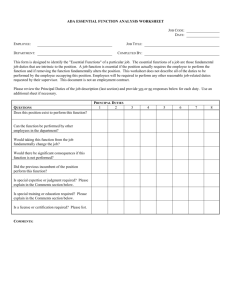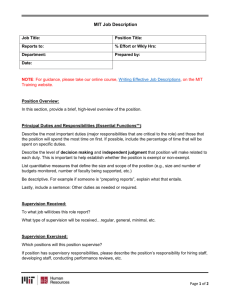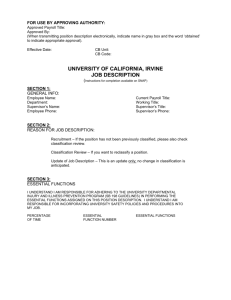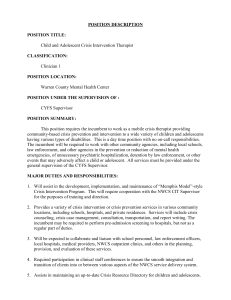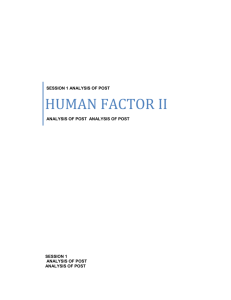Guidelines to Writing a Job Description
advertisement
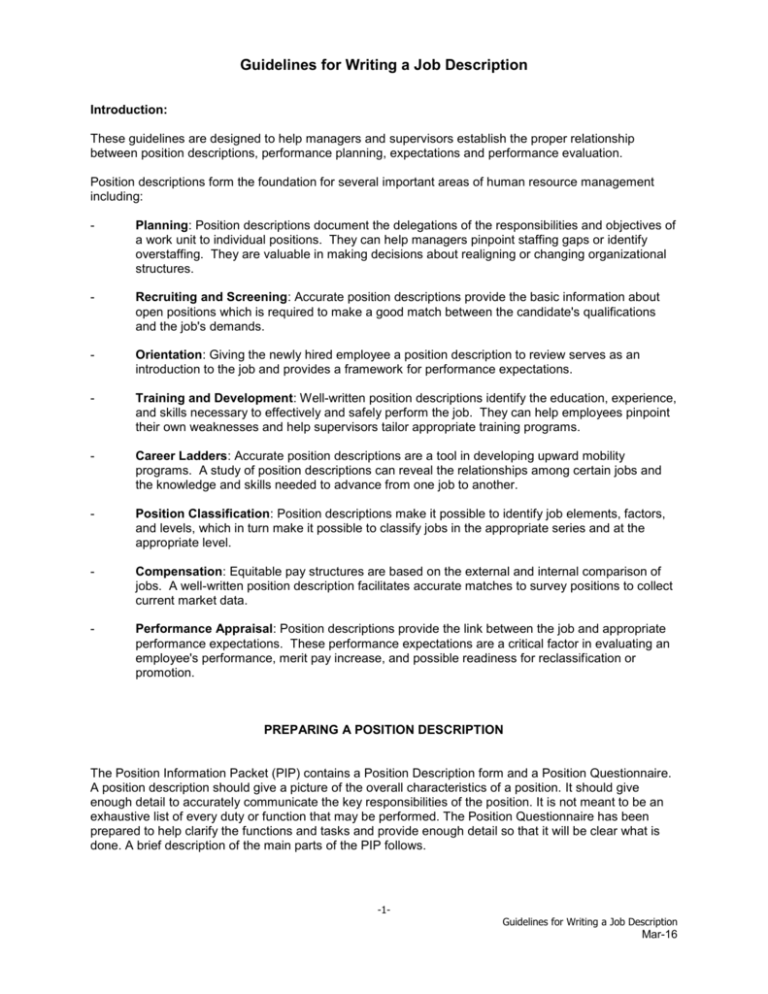
Guidelines for Writing a Job Description Introduction: These guidelines are designed to help managers and supervisors establish the proper relationship between position descriptions, performance planning, expectations and performance evaluation. Position descriptions form the foundation for several important areas of human resource management including: - Planning: Position descriptions document the delegations of the responsibilities and objectives of a work unit to individual positions. They can help managers pinpoint staffing gaps or identify overstaffing. They are valuable in making decisions about realigning or changing organizational structures. - Recruiting and Screening: Accurate position descriptions provide the basic information about open positions which is required to make a good match between the candidate's qualifications and the job's demands. - Orientation: Giving the newly hired employee a position description to review serves as an introduction to the job and provides a framework for performance expectations. - Training and Development: Well-written position descriptions identify the education, experience, and skills necessary to effectively and safely perform the job. They can help employees pinpoint their own weaknesses and help supervisors tailor appropriate training programs. - Career Ladders: Accurate position descriptions are a tool in developing upward mobility programs. A study of position descriptions can reveal the relationships among certain jobs and the knowledge and skills needed to advance from one job to another. - Position Classification: Position descriptions make it possible to identify job elements, factors, and levels, which in turn make it possible to classify jobs in the appropriate series and at the appropriate level. - Compensation: Equitable pay structures are based on the external and internal comparison of jobs. A well-written position description facilitates accurate matches to survey positions to collect current market data. - Performance Appraisal: Position descriptions provide the link between the job and appropriate performance expectations. These performance expectations are a critical factor in evaluating an employee's performance, merit pay increase, and possible readiness for reclassification or promotion. PREPARING A POSITION DESCRIPTION The Position Information Packet (PIP) contains a Position Description form and a Position Questionnaire. A position description should give a picture of the overall characteristics of a position. It should give enough detail to accurately communicate the key responsibilities of the position. It is not meant to be an exhaustive list of every duty or function that may be performed. The Position Questionnaire has been prepared to help clarify the functions and tasks and provide enough detail so that it will be clear what is done. A brief description of the main parts of the PIP follows. -1- Guidelines for Writing a Job Description Mar-16 Position Description: The main purpose of the job: This section should briefly describe the basic purpose of the job and the general level of difficulty and responsibility. The level of supervision received is usually the starting point for this section. Any characteristics that distinguish this particular job from higher or lower level jobs should be included here. Duties and tasks: This section identifies the essential and non-essential functions of the position and the related tasks performed. A function is a major duty performed by or an area of responsibility assigned to an employee. Tasks are particular work actions performed to accomplish one area of responsibility. Typically, employees perform five to seven major functions. Position Questionnaire: The questions in the questionnaire help to clarify and define the position. They cover such areas as development of procedures, examples of writing assignments, gathering and analyzing of information, reference materials used, equipment used, and decision making authority. They assist the employee and the supervisor in explaining the scope and level of responsibilities. The Budgetary/Supervisorial Duties page is provided to outline the amount and types of funds for which the incumbent is responsible; and, to identify the level of supervisory authority delegated. The final page ("Page 8") of the questionnaire covers the physical and mental requirements of the position; education and experience requirements; special conditions of employment; the identification of whether the position is critical; and the required signature lines. STEPS IN WRITING A POSITION DESCRIPTION MAKE LISTS 1. Functions and Tasks - - Make a list of the primary functions of the position List the tasks associated with those functions 2. Contacts - Make a list of everyone the incumbent has to interface with in order to do the job (excluding the supervisor and co-workers). Group the lists by those within the Office of the President and those outside the Office of the President. 3. Equipment/Tools - List the equipment, tools, or machines used in the job 4. Reference Materials/Manuals - List reference materials, procedures manuals, etc. used in performing the job 5. Physical and Mental Requirements - Make a list of physical and mental requirements of the job -2- Guidelines for Writing a Job Description Mar-16 6. Knowledge/Education/Experience - Make a list of knowledge, skills, experience, education, and special licenses needed Group the list by similar categories 7. Budgetary/Supervisory Responsibilities (if applicable) - List the amount of funds this position is responsible for and the level of authority over those funds List the number and types of positions the incumbent supervises; and the level of authority for actions such as hiring, disciplining, and assigning work - STATE WHAT IS DONE 1. Use action verbs - See the Job Description Glossary 2. Tell what is done 3. Tell why or how task is performed 4. Add examples if necessary 5. Be specific and concise DEVELOP FUNCTION AND TASK STATEMENTS In the functions/duties and tasks section, functions should be listed in order of priority. Specific tasks associated with each responsibility should be grouped together. Please remember that a position description is not intended to be a desk manual. You do not need to list every task performed within a job. When writing function and task statements you should: 1. Begin each task statement with an action word (verb), which describes a specific kind of behavior. 2. Describe what, how and why each task is performed. 3. Estimate the percentage of time spent on each function. Note that the percent of time spent and the priority of the work are not necessarily related. 4. Define uncommon abbreviations. 5. Do not include references to personal qualities or skills. Example: Prepare budget materials: Plan and prepare the annual budget by integrating department goals and program plans, administrative requirements, and staff and other statistical data. Prepare budget summaries and updates based on actual expenditures. Example: Prepare reports: Prepare statistical tables by finding sources of basic information, planning the schedule and means of collecting information, designing tables and writing interpretive text. Example: Edit manuscripts by reviewing critically from subject matter standpoint, checking and verifying content, condensing topics, making additions to topics and rearranging material. -3- Guidelines for Writing a Job Description Mar-16 COMPLETING THE POSITION QUESTIONNAIRE The questionnaire provides additional information which helps to clarify the duties and responsibilities of the position. Item Description 1 This section identifies the individuals and organizations that the incumbent has to interact with within and outside the Office of the President. Generally, titles should be used, e.g., Purchasing staff, Admissions Officers, Travel Agents, etc., as opposed to names since these may change. The purpose of the contact and estimated frequency are also listed. 2–6 These questions identify responsibilities for development of procedures and methods; interpreting and/or implementing policies; decision making; authorization for funds; and writing responsibilities. Again, these questions help to define the scope and level of authority delegated to this position. 7–11 These questions describe presentations made by the employee; equipment and tools used; analytical aspects of the job, e.g., information gathering, identification of issues, development and analysis of alternative solutions, and recommendations made. They also identify the type of work assigned, i.e., daily assignments, projects, develop own assignments; and, the reference materials used to perform the job. 12–16 These questions ask for information related to the physical and mental requirements needed for effectively and safely performing the functions of the job. They also cover the working conditions; education, experience or specialized training required; special conditions of employment, and type of supervision received. In addition, the identification of critical positions which are subject to a background check is noted here. Budgetary/Supervisorial Duties The Budgetary/Supervisorial Duties page should be completed for those positions assigned budgetary and/or supervisory responsibilities. The amount of funds and the level to which authority is granted should be identified. For example, an Administrative Assistant may have responsibility for monitoring expenses for certain accounts, following up with vendors or the Accounting Department to resolve problems; and, a Management Services Officer may have responsibility for authorizing payments and reconciling the ledger for the department. The supervisory section identifies the number and level of staff supervised and the authority level for personnel actions. For example, a supervisor may have authority for assigning and reviewing work, but not have authority to approve overtime without the prior approval of the manager. THE FINAL DRAFT The last steps required before preparing the final draft include identifying the essential and nonessential functions according to the Americans with Disabilities Act guidelines; and determining the requirements of the position. The following chart provides information and questions to consider to assist you in identifying the essential functions of the position. -4- Guidelines for Writing a Job Description Mar-16 DETERMINING ESSENTIAL AND NON-ESSENTIAL FUNCTIONS In compliance with the Americans with Disabilities Act (ADA) of 1990, supervisors must determine and identify which functions are essential functions of the particular position (Must be performed by this position). According to the ADA guidelines, a function may be determined to be essential to the work of the unit but not necessarily essential to a particular position, e.g., a function must be done, but another staff member could perform it. For each function listed, consider the following: - Are employees currently in the same classification actually required to perform the function? - If a function is removed, would that fundamentally change the job? - Does the position exist primarily to perform this function? - Are there a limited number of other employees available to perform the function, or among whom the function can be distributed? - Is the function highly specialized, and the person in the position is hired for that expertise? The ADA regulations list several types of evidence to determine whether a function is essential: - The employer's judgement that a function is essential; - A written job description prepared before advertising or interviewing applicants for a job; - The amount of time spent performing the function; - The consequences of not requiring a person in the job to perform the function; - The terms of a collective bargaining agreement which define duties to be performed in particular jobs; - The work experience of people who have performed the job in the past and work experience of people who currently perform the job; and, - Other relevant factors such as the nature of the work operation and the employer's organizational structure. Those functions which do not meet the above considerations are considered non-essential or marginal functions of this position. REQUIRED ELEMENTS ("PAGE 8") "Page 8" of the Position Questionnaire contains information required in the preparation of any position description. This includes descriptions for casual positions, vacant new positions, and positions being reviewed for reclassification. This page covers items 12–16, including requirements of the position, identification of critical positions, and type of supervision received. -5- Guidelines for Writing a Job Description Mar-16 Requirements of the Position Physical and Mental Requirements: Physical requirements deal with such things as seeing, hearing, lifting, carrying, pushing, standing, etc., and the frequency of the actions. Mental requirements deal with such things as reasoning, discriminating, performing math calculations, and problem solving. The work environment should also be described. If the position is primarily an office or sedentary one, you may just say "office." If environmental hazards such as exposure to extreme or varying temperature, noise, or fumes exist, please provide this information. Statements which prescribe how a function is or should be done should not be included. These may constitute artificial barriers for qualified individuals who could perform the job with reasonable accommodation. Education, Experience or Training: In this section, the level of skills, knowledge and abilities required for effective and safe performance of the essential and non-essential functions of the job should be indicated. Vocational or work content skills are those dealing with mastering a particular vocabulary, procedure or subject matter. Skills can include vocational/technical or work content, reading, writing, speaking, mathematical, human relations, reasoning or self-management. Level of knowledge may be defined as follows: General Knowledge – Understanding of the principles of a field. Knowledge of the information contained in source documents or general types of information covered in a subject field. Working Knowledge – Includes general knowledge plus the ability to recall important and commonly used information in source documents, and an understanding of the application of the pertinent principles in a subject field. Detailed Knowledge –Mastery of the principles of a field, or a thorough understanding of a specialized area of a field. Special Conditions of Employment: This section is used to identify other conditions which are not skills, knowledge’s, abilities or physical requirements needed to perform the duties of the job. For example, scientific expertise, foreign language fluency, licenses, availability for travel, etc. These conditions must be documented to establish their job-relatedness. Types of Supervision Received: This should indicate the level of supervision the incumbent will receive after the initial training/orientation period. Close Supervision indicates the incumbent is assigned duties according to specified procedures and work is checked frequently. Supervision indicates the incumbent performs a variety of routine duties within established policies and procedures or by referral to supervisor's guidelines. General Supervision indicates the incumbent develops procedures for performance of a variety of duties; or performs complex duties within established policy guidelines. Direction indicates that the incumbent establishes procedures for attaining specific goals and objectives in a broad area of work. Only the final results of work done are typically reviewed. The incumbent typically develops procedures within the limit of establish policy guidelines. -6- Guidelines for Writing a Job Description Mar-16 General Direction indicates that the incumbent receives guidance in terms of broad goals and objectives and is responsible for establishing the methods to attain them. Generally the incumbent is in charge of an area of work, and typically formulates policy for this area but does not necessarily have final authority for approving policy. Identifying Critical Positions – Financially Based The list of critical positions is maintained in Personnel Services. The level and type of background check varies with the type of position and the criteria involved, for example, a verification of licensure to a check for a criminal conviction record. Positions have been identified as critical by departments and designated as such by the Senior Vice President—Business and Finance (as Chancellor) based on the following criteria. 1. Master key access to residence and other facilities 2. Direct responsibility for the care, safety, and security of humans; or the safety and security of personal or University property 3. Direct access to or responsibility for cash, checks, or University property disbursements or receipt 4. Direct access to or responsibility for controlled substances 5. Extensive authority for committing the financial resources of the University 6. Responsibility for operating vehicles, machinery, or toxic systems that could cause death, injury, or health problems 7. A requirement for a professional license, certificate, or degree, the absence of which would expose the University to legal liability and/or adverse public reaction 8. Direct access to and/or responsibility for information affecting national security Identifying Critical Positions – Youth Based All prospective ANR employees who are expected to have supervisory responsibility for youth will have a background investigation performed as part of the employment process. Applicants must cooperate fully and provide fingerprints, information and/or consent, as necessary, to conduct the background investigation. In addition, the ANR unit administrator with the responsibility for making the determination as to who is subject to this policy must also have a background check completed; and, as required by state law, staff who review or handle criminal records for employees or volunteers must have a background check. At the supervisor's discretion, other employees may be required to be fingerprinted if they might have responsibility for youth or could be in a position to review the criminal records resulting from background investigations. DEFINITIONS RELATED TO BACKGROUND INVESTIGATIONS FOR POSITIONS SUPERVISING YOUTH 1. Direct Contact Having supervisory or disciplinary responsibility for youth under the age of 18 years. 2. Responsible Unit The person who is the hiring authority for the Administrator position in question. This is usually the County Director, or similar level administrator, but not always. For County Director positions, the Regional Director is the responsible administrator. 3. Supervision Person having direct responsibility for the welfare and safety of youth or disciplinary authority over youth. This may or may not be the only adult present with children. -7- Guidelines for Writing a Job Description Mar-16 4. Job Title A working job title is that which is commonly accepted for the position. 5. Job Description The job description is the official description of the employee’s duties. The description of the duties related to supervisory responsibility for youth may appear in any of these sections of a job description: a. Nature and Purpose b. Major Duties and Responsibilities c. Essential Functions d. Duties and Tasks e. Position Requirements 6. Job Convention Job convention means the actual duties and responsibilities of the employee regardless of job title or description. The employee is involved in activities with youth if he or she has supervision responsibility for youth, when he or she directs or works with youth without the direct physical supervision of another employee, or where there is a reasonable expectation that the employee will be the sole adult working directly with the youth. 7. Criminal Records Handler Any employee (UC or County) who has access to results of the background investigation process for either employees or volunteers, including the review of criminal records obtained from DOJ or FBI, must be fingerprinted and cleared under State law. All of the information collected and compiled should be entered in the Position Information Packet, including the Position Description and the Position Questionnaire. A word processing document covering all of the appropriate sections may be substituted for the actual form. Signatures: For vacant positions, the supervisor should sign on the last page of the position description. And, the supervisor and Department Head should sign on the last page of the position questionnaire. If there is an incumbent in the position, the incumbent should sign on the position description and the last page of the position questionnaire. -8- Guidelines for Writing a Job Description Mar-16
